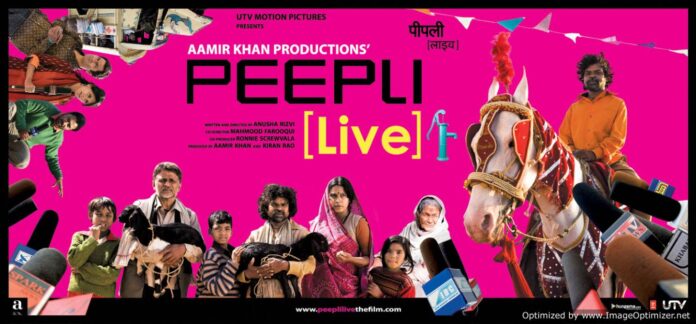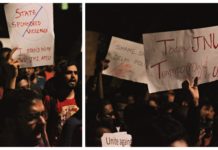Farmer suicides, or the economic condition of farmers broadly, has not been a subject of popular interest in the Bollywood film industry. Films like Mother India (1957), Ganga Jumna (1961) and Upkaar (1967) dealt with issues like rural poverty and exploitation of the peasants by zamindar and moneylenders. Peepli Live is a recent exercise in exploring farmer’s issues in Hindi cinema, directed by Anusha Rizvi and Mahmood Farooqui, and produced as a “cinema of concern” by Aamir Khan within mainstream Bollywood cinema.
The protagonists of the movie are Natha and Budhiya, who consider committing suicide in order to avail the compensation of 1 lakh from the government to repay their bank loan. As the news gets picked up by the local newspaper, and spreads to national news channels as well, it is sensationalised by the media and their plight becomes a new game in the hands of those in power. The film unfolds like a hard-hitting satire that casts a gaze over a range of ‘real issues’ bothering ‘real people’ in contemporary India: the pathetic condition of rural economy, the ever-growing rural-urban divide, vote-bank politics, a political class that is not really bothered about the poor farmers, and the corporatised media houses owned by political parties and lusting for TRP.
A couple of brilliant scenes capture the futility of the development mechanism that India has adopted. In one scene, a local official is seen to be gifting Natha a ‘Lal Bahadur’ (read hand pump), without providing him the means to install it. Not surprisingly, the hand pump is left unused in the courtyard and soon becomes a play thing for the kids. In another scene, Natha is being gifted a colour television, that would remind one of Marie Antoinette saying, ‘If they don’t have food, let them have cake!’ In yet another scene, one finds officials running their heads through an array of official documents concerning the ‘garibi hatao’ schemes, only to realise that nothing addresses the specific issue of farmer suicides (TOI, 2016).
The film gains points in portraying the true rustic character of its protagonists through the cast that it employs, but the authenticity is limited to their accent and non-verbal gestures. The focus of the film does not revolve around the protagonist and his family, and deliberately ignores the intimate familial dynamics. As a result, it exhibits concern for a certain section of the society without identifying with them. The audience is overtly made aware that the rural protagonists belong to a different world, and therefore, the agrarian crisis seems like a myth. The agrarian crisis should be understood and therefore analysed as a multi-layered complex structural failure stemming from corporatisation of agriculture, industrialisation, privatisation and liberalisation, economic destabilisation and hence, deprivation in the rural agricultural sector. These capitalist processes often have state sanctions, wherein the state becomes the violent architect of large scale migrations and farmer suicides.
One can find some critique of the media and our political system herein, but the film fails to provide an insight into the politics behind agricultural subsidies, indebtedness and suicides. Peepli Live claims to be politically driven, but does not scratch below the surface of the complex web of agrarian crisis, and therefore its reception presents a “pseudo-liberal aura of political consciousness, intellectuality and morality”. The fact that the film does not really critique state policies, or the corporate houses, and like always downplays the role of caste and class dynamics in a typical rural setup in India, reflects on the class and corporate interests that it is probably catering to.
Peepli Live is non-committal and deceptive in its approach towards rural indebtedness, unlike movies like Mother India and Upkaar. This can be attributed to the fact that corporatisation of the economy has increased mobility and diversified capital usage, that was not present in the 1950s and 1960s. Earlier, films could be produced independently, unlike now when production is dependent on other benefactors of the economy as well, especially those attacked in such movies (e.g., moneylenders, landowners, etc.).
If the film had dealt with the incapacity of corporates as a reason behind indebtedness, or micro-finance as a severe usury, it would have had a better impact. But needless to say, that could have disturbed certain financing agencies for the next ‘socially concerned’ movie, and even the big corporate houses. Hence, Peepli Live has tactfully avoided the two most probable causes for rural indebtedness, and also depicted that very little can be done on a structural level to address this grave matter.
Despite several reports showing high correlation between farmer suicides and the caste/ class the farmer belongs to, none of this seems to be challenged in the film. Another important aspect that has been trivialised much is the issue of massive migration of farmers to the cities in search of better livelihood options, away from the vicious cycle of drought, indebtedness and deprivation. One finds Natha as a construction worker in Delhi in the closing scene, but there exists no critical insight as to how he ended up there. The audience is made to believe that it is an escape from the intrusive media. The satire, hereby, turns into a mere caricature of a deprived rural agrarian life, and the political issue becomes camouflaged behind a circus orchestrated by political leaders and the media.
Though one cannot critique a film on the lines of how it should have better portrayed the storyline, Peepli Live recognises itself as humanist, and quite intentionally evades the political and economic issues at play. Indebtedness followed by suicide is viewed from a humanist point of view, and the numerous economic causes that force farmers to take loans and opt for alternate cropping patterns are largely ignored. The film, in an attempt to realistically represent a political satire, ends up making a mockery of a situation as grave as farmer suicides.




























